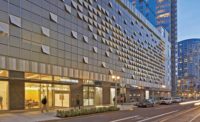Excavation hits water
The 11-story maternity center and two-story pediatric center sit atop a concave four-story podium, supported by an 8-ft deep or greater mat foundation. Preparation for the project required demolition of a bank building and implosion of a 13-story hotel.
The 56-ft excavation for the four-story, 1,000-car, underground parking garage required digging 11 ft below the water table, increasing the difficulty of the dewatering process. Initially, Bellows drilled wells around the perimeter, but that system did not keep the hole dry when the team ran into an underground stream. At about 50 ft down, the company had to install a second system, drilling inside the excavation. “We had to improvise and add some battered wells in between each retention pier,” Kubin says.
Shirley reports that crews pumped more than 270 gallons of water per minute out of the hole as contractors poured concrete. As a result, it took almost two months longer than expected to complete the pour. Although the additional dewatering affected the early schedule, the team was able to compress the schedule later by “going 110 miles per hour,” Pearsall says. More than 1,000 craft workers labored on site during the last months of construction.
Squeezing in cables and pipes
FKP designed the structure using building information modeling (BIM), which uncovered potential ductwork going through beams and glass walls floating outside the structure, Shirley says. Even so, the team was “challenged daily on ceiling conflicts and coordination above the ceiling and in the walls,” says Kubin. The team lost about a month at the beginning of the job trying to coordinate one of the podium floors, but ultimately turned it back to the engineers to redesign and open up spaces for the MEP trades.
“We did get into one area where, for various reasons, there was a challenge with available space,” Gray says. “We identified the problem through using building information modeling before it was constructed.”
Gray adds that Smith Seckman Reid had to make some significant changes to the design on the third floor to make it work. But the modifications did not slow the project, and there was no impact on cost. “That was a significant benefit of the BIM process on this project,” Gray says.
FKP “printed” a three-dimensional model, using a Z Corp. printer, and perused the space in Houston-based structural and civil engineer Walter P Moore's Visionarium, a 25-ft-wide projection screen that wraps toward the audience. “When you put the model up at that scale and start walking through it, it's almost like you are in the building,” Shirley says.
Smith Seckman Reid designed the building to operate more efficiently than code minimums, using a lighting strategy that incorporated LED fixtures and a single-fan, dual-duct HVAC system. Gray estimates energy consumption will be less than required for LEED certification, although the hospital is not seeking it, due to the cost.
“We invested in smart, sustainable decisions that were within a five-year payback,” Pearsall said.
Pedestrian bridge
A curved, two-story, air-conditioned pedestrian bridge that is 580 ft long and 34 ft tall connects the Women's Pavilion with the main Texas Children's Hospital tower and an ambulatory care center. Spanning a light rail track and a road, it is the largest oval bridge in Texas, according to FKP. The bridge, covered with curtain wall and aluminum cladding, is built to withstand 130 mph gusts of wind.









Post a comment to this article
Report Abusive Comment